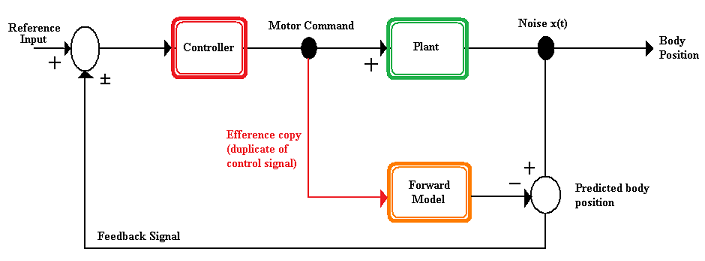
Sensory-motor coupling
Sensory-motor coupling is the coupling or integration of the sensory system and motor system. Sensorimotor integration is not a static process. For a given stimulus, there is no one single motor command. "Neural responses at almost every stage of a sensorimotor pathway are modified at short and long timescales by biophysical and synaptic processes, recurrent and feedback connections, and learning, as well as many other internal and external variables".[1]
Examples[edit]
Gaze stabilization[edit]
During flight, it is important for a fly to maintain a level gaze; however, it is possible for a fly to rotate. The rotation is detected visually as a rotation of the environment termed optical flow. The input of the optical flow is then converted into a motor command to the fly's neck muscles so that the fly will maintain a level gaze. This reflex is diminished in a stationary fly compared to when it is flying or walking.[1]
Singing crickets[edit]
Male crickets sing by rubbing their forewings together. The sounds produced are loud enough to reduce the cricket's auditory system's response to other sounds. This desensitization is caused by the hyperpolarization of the Omega 1 neuron (ON1), an auditory interneuron, due to activation by auditory stimulation.[5] To reduce self-desensitization, the cricket's thoracic central pattern generator sends a corollary discharge, an efference copy that is used to inhibit an organism's response to self-generated stimuli, to the auditory system.[1][5] The corollary discharge is used to inhibit the auditory system's response to the cricket's own song and prevent desensitization. This inhibition allows the cricket to remain responsive to external sounds such as a competing male's song.[8]
Speech[edit]
Sensorimotor integration is involved in the development, production, and perception of speech.[9][10]
Disorders[edit]
Parkinson's[edit]
Patients with Parkinson's disease often show symptoms of bradykinesia and hypometria. These patients are more dependent on external cues rather than proprioception and kinesthesia when compared to other people.[11] In fact, studies using external vibrations to create proprioceptive errors in movement show that Parkinson's patients perform better than healthy people. Patients have also been shown to underestimate the movement of limb when it was moved by researchers.[11] Additionally, studies on somatosensory evoked potentials have evidenced that the motor problems are likely related to an inability to properly process the sensory information and not in the generation of the information.
Huntington's[edit]
Huntington's patients often have trouble with motor control. In both quinolinic models and patients, it has been shown that people with Huntington's have abnormal sensory input. Additionally, patients have been shown to have a decrease in the inhibition of the startle reflex. This decrease indicates a problem with proper sensorimotor integration. The " various problems in integrating sensory information explain why patients with HD are unable to control voluntary movements accurately."[11]
Dystonia[edit]
Dystonia is another motor disorder that presents sensorimotor integration abnormalities. There are multiple pieces of evidence that indicate focal dystonia is related to improper linking or processing of afferent sensory information in the motor regions of the brain.[11] For example, dystonia can be partially relieved through the use of a sensory trick. A sensory trick is the application of a stimulus to an area near to the location affected by dystonia that provides relief. Positron emission tomography studies have shown that the activity in both the supplementary motor area and primary motor cortex are reduced by the sensory trick. More research is necessary on sensorimotor integration dysfunction as it relates to non-focal dystonia.[11]
Restless leg syndrome[edit]
Restless leg syndrome (RLS) is a sensorimotor disorder. People with RLS are plagued with feelings of discomfort and the urge to move in the legs. These symptoms occur most frequently at rest. Research has shown that the motor cortex has increased excitability in RLS patients compared to healthy people. Somatosensory evoked potentials from the stimulation of both posterior nerve and median nerve are normal.[12] The normal SEPs indicate that the RLS is related to abnormal sensorimotor integration. In 2010, Vincenzo Rizzo et al. provided evidence that RLS sufferers have lower than normal short latency afferent inhibition (SAI), inhibition of the motor cortex by afferent sensory signals. The decrease of SAI indicates the presence of abnormal sensory-motor integration in RLS patients.[12]